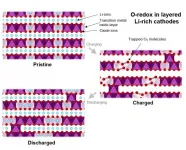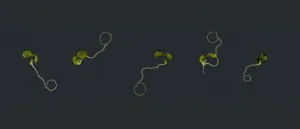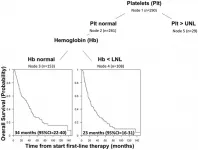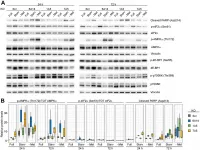Potential target for treating many cancers found within GLI1 gene
2021-03-01
(Press-News.org) Scientists from the Stanley Manne Children's Research Institute at Ann & Robert H. Lurie Children's Hospital of Chicago found that a region within the DNA of the cancer-promoting GLI1 gene is directly responsible for regulating this gene's expression. These findings, published in the journal Stem Cells, imply that this region within GLI1 could potentially be targeted as cancer treatment, since turning off GLI1 would interrupt excessive cell division characteristic of cancer.
"From previous research, we know that GLI1 drives the unrelenting cell proliferation that is responsible for many cancers, and that this gene also stimulates its own expression," says co-senior author Philip Iannaccone, MD, PhD, Professor Emeritus at the Manne Research Institute at Lurie Children's and Northwestern University Feinberg School of Medicine. "We established in living human embryonic stem cells that removing the GLI1 regulatory region eliminated GLI1 expression and halted its activity. These findings are promising and could point to a therapeutic target for cancer."
Dr. Iannaccone and colleagues used CRISPR gene editing technology to delete the binding region of the GLI1 DNA in human embryonic stem cells. They found that without this region, GLI1 remained turned off, which interfered with the gene's normal activity of driving embryonic development of blood, bone, and nerve cells.
"A surprising aspect of this work was that turning GLI1 off affected stem cell differentiation to all three embryonic lineages," says first author Yekaterina Galat, BS, Research Associate at the Manne Research Institute at Lurie Children's.
"The developmental function of GLI1 ends after birth, so if we manage to stop its expression in the context of cancer, it should not have negative consequences to normal biology," explains Dr. Iannaccone.
GLI1 expression is associated with about a third of all human cancers. In addition to promoting cell proliferation, GLI1 expression increases tumor cell migration and is associated with resistance to chemotherapy drugs.
"Our team plans to study GLI1 associated proteins that assist in regulation of GLI1 expression through its binding region," says Dr. Iannaccone. "Targeting these proteins as a means to stop GLI1 activity could prove to be a fruitful treatment strategy for cancer."
INFORMATION:
In addition to Dr. Iannaccone and Yekaterina Galat, the publication authors include Haigang Gu, Mariana Perepitchka, Robert Taylor, Joon Won Yoon, Xenia A. Glukhova, Xiao-Nan Li, Igor P Beletsky, David O. Walterhouse, and Vasiliy Galat.
This work was supported in part by the National Institutes of Health (P01ES010549) and the Eisenberg Foundation for Charities.
Research at Ann & Robert H. Lurie Children's Hospital of Chicago is conducted through the Stanley Manne Children's Research Institute. The Manne Research Institute is focused on improving child health, transforming pediatric medicine and ensuring healthier futures through the relentless pursuit of knowledge. Lurie Children's is ranked as one of the nation's top children's hospitals by U.S. News & World Report. It is the pediatric training ground for Northwestern University Feinberg School of Medicine. Last year, the hospital served more than 220,000 children from 48 states and 49 countries.
ELSE PRESS RELEASES FROM THIS DATE:
2021-03-01
Scientists from Far Eastern Federal University (FEFU) together with Russian and German colleagues, continue studying antitumor compounds synthesized based on bioactive molecules isolated from a sea sponge. One of them fights cancer cells resistant to standard chemotherapy, and at the same time has an interesting dual mechanism of action. A related article appears in Marine Drugs.
Scientists have tested the biological effect of the marine alkaloid 3,10-dibromofascaplysin on various prostate cancer cells, including those resistant to standard docetaxel-based chemotherapy. ...
2021-03-01
CORVALLIS, Ore. - In tropical oceans, a combination of sunlight and weak winds drives up surface temperatures in the afternoon, increasing atmospheric turbulence, unprecedented new observational data collected by an Oregon State University researcher shows.
The new findings could have important implications for weather forecasting and climate modeling, said Simon de Szoeke, a professor in OSU's College of Earth, Ocean, and Atmospheric Sciences and the lead author of the study.
"The ocean warms in the afternoon by just a degree or two, but it is an effect that has largely been ignored," said de Szoeke. ...
2021-03-01
HARWELL, UK (1 March 2021) Scientists based at the University of Oxford as part of the Faraday Institution CATMAT project researching next-generation cathode materials have made a significant advance in understanding oxygen-redox processes involved in lithium-rich cathode materials. The paper, published in Nature Energy, proposes strategies that offer potential routes to increase the energy density of lithium-ion batteries.
"In the ever more difficult quest to make incremental improvements to Li-ion battery energy density, being able to harness the potential of oxygen-redox cathodes and the bigger improvements they offer relative to the nickel rich cathodes in commercial use today is potentially significant," Prof Peter Bruce, University ...
2021-03-01
Childhood cancer and its treatment can result in cognitive struggles. Scientists atSt. Jude Children's Research Hospital are studying the risk factors. They looked at social and economic issues in children with brain tumors treated with radiation.
These patients have the greatest risk of cognitive problems. Scientists followed a group of St. Jude patients for 10 years. The children all had conformal radiation therapy.
For each patient, researchers looked at certain factors. These included the parent's job, education level, and whether it was a single parent home. The children were from different backgrounds.
The findings show social and economic status is linked to IQ, academics, attention ...
2021-03-01
Amsterdam, March 1, 2021 - Comfort is a daily human experience central to the perception of our environment and the continuous processing of sensory input. Environmental factors such as smell, temperature and light can influence comfort, as can our interaction with products, such as the design of a chair or a mattress. Increasingly, researchers investigating the science of comfort and discomfort are focusing on the role of human behavior. A special supplement to the journal WORK presents the latest advances, from optimal seat design in offices and transportation to the influence of smell on comfort and the interaction between time and comfort.
"This special supplement adds unique findings to comfort knowledge. ...
2021-03-01
A novel targeted immunotherapy approach developed by researchers at the Ludwig Center, the Lustgarten Laboratory, and Bloomberg~Kimmel Institute for Cancer Immunotherapy at the Johns Hopkins Kimmel Cancer Center employs new antibodies against genetically altered proteins to target cancers.
The researchers targeted their immunotherapy approach to alterations in the common cancer-related p53 tumor suppressor gene, the RAS tumor-promoting oncogene or T-cell receptor genes. They also tested the therapy on cancer cells in the laboratory and in animal tumor models. Their findings are reported in three related studies published March 1 in Science Immunology, Science and Science Translational Medicine.
Two ...
2021-03-01
Scientists have identified that the COVID-19 virus could be transmitted through faecal contaminated river water.
A team of researchers, including water quality, epidemiology, remote sensing and modelling experts, led by Dr Jamie Shutler at the University of Exeter, have developed a fast and simple way to assess the potential risk of water-borne transmission of the COVID-19 virus, posed by sewage spills into open and closed freshwater networks.
The new study, published in the journal Environmental Science and Technology - Water, identifies the relative risk of viral transmission by sewerage spills, across 39 different counties.
The study used information on the environment, a population's infection rate, and water usage to calculate the potential potency of ...
2021-03-01
Plants grow towards the light. This phenomenon, which already fascinated Charles Darwin, has been observed by everyone who owns houseplants. Thus, the plant ensures that it can make the best use of light to photosynthesize and synthesize sugars. Similarly, the roots grow into the soil to ensure that the plant is supplied with water and nutrients.
These growth processes are controlled by a hormone called "auxin", which plays a key role in the formation of polarity in plants. To do this, auxin is transported in the plant body polar, from the shoot through the plant body into the roots. In this process, a family of polar transport proteins distributes the auxin throughout the plant. To ...
2021-03-01
The cover for issue 49 of Oncotarget features Figure 4, "CART-Tree analysis for overall survival in IMDC intermediate risk group," by Guida, et al.recently published in "Identification of international metastatic renal cell carcinoma database consortium (IMDC) intermediate-risk subgroups in patients with metastatic clear-cell renal cell carcinoma" which reported that as these patients have different prognosis, the aim of this study is to better characterize IR patients in order to better tailor the treatment.
A multivariable Cox model with backward selection procedure and a Classification and Regression Tree analysis were performed to identify which prognostic factors were associated to OS in IR patients.
Median OS for patients with ...
2021-03-01
Oncotarget recently published "Exploiting the metabolic dependencies of the broad amino acid transporter SLC6A14" which reported that Tumor cells typically enhance their metabolic capacity to sustain their higher rate of growth and proliferation.
One way to elevate the nutrient intake into cancer cells is to increase the expression of genes encoding amino acid transporters, which may represent targetable vulnerabilities.
The Oncotarget authors analyze the pattern of transcriptional changes in a panel of breast cancer cell lines upon metabolic stress and found that SLC6A14 expression levels are increased in the absence of methionine.
Methionine deprivation, which can be achieved via modulation of dietary methionine intake in tumor cells, in turn leads to a heightened ...
LAST 30 PRESS RELEASES:
[Press-News.org] Potential target for treating many cancers found within GLI1 gene







